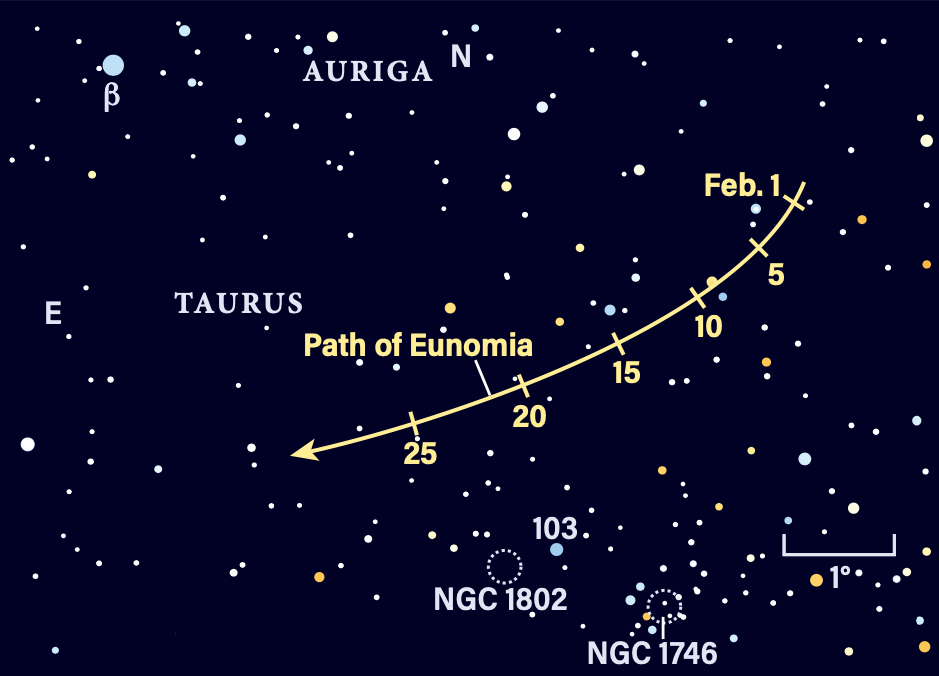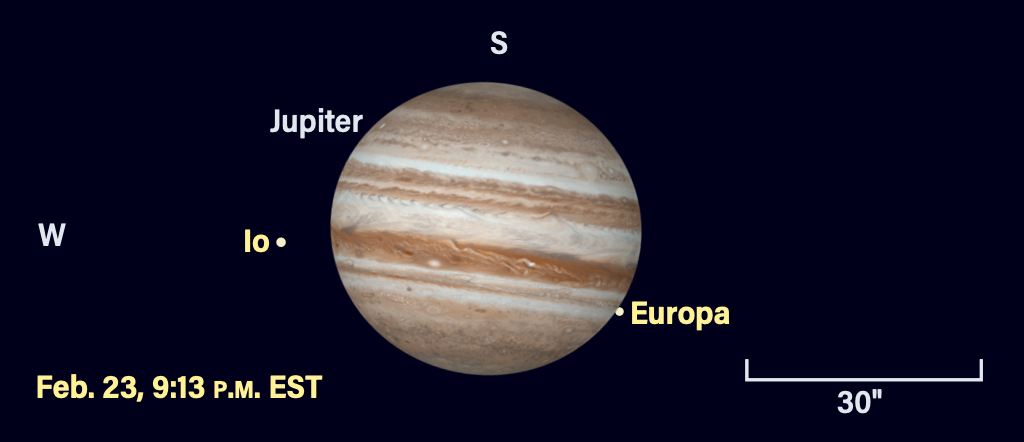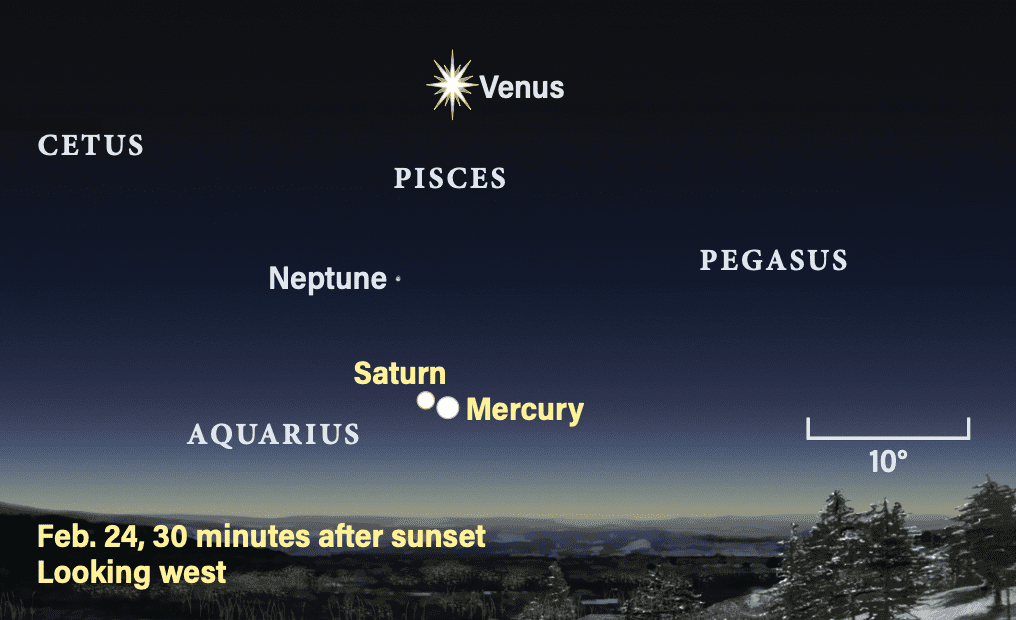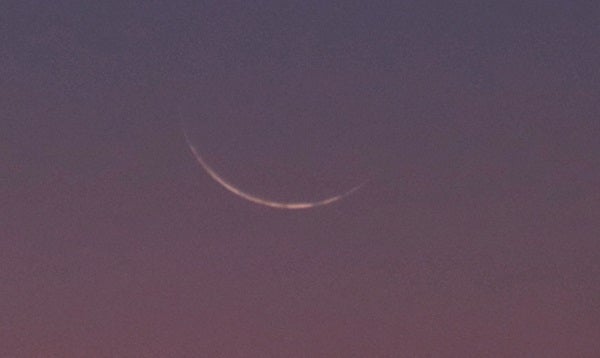Mercury and Saturn stand side by side in the early-evening sky near the end of February. Note that Neptune is not visible to the naked eye. Credit: Astronomy: Roen Kelly
Friday, February 21
The Moon passes 0.4° south of the bright red giant Antares in Scorpius this morning at 4 A.M. EST. The pair is visible in the predawn sky.
This evening, let’s look for another bright red giant: Betelgeuse, the famous star that serves as one shoulder of Orion the Hunter. An hour after sunset, Betelgeuse is more than 50° high in the south, as Orion appears to stand upright with his bow facing to the right (west). Betelgeuse is easy to recognize, standing above the leftmost star in Orion’s Belt in this orientation.
Betelgeuse shines at magnitude 0.5 and is a red supergiant — similar to slightly fainter (magnitude 0.9), less massive red giant Aldebaran to its upper right in Taurus the Bull. Roughly 570 light-years away, Betelgeuse grabbed the attention of amateur and professional astronomers a few years ago when it mysteriously dimmed, which researchers now think was due to a dust cloud “sneezed” out by the aging star and temporarily blocking some of its light.
Even with the naked eye, you can see that Betelgeuse’s light is orangey-red. It really stands out in binoculars or a telescope. Compare it both to Aldebaran and to Mars — the Red Planet lies to the upper left of Orion early this evening, roughly in the middle of Gemini the Twins.
Sunrise: 6:44 A.M.
Sunset: 5:44 P.M.
Moonrise: 2:04 A.M.
Moonset: 10:57 A.M.
Moon Phase: Waning crescent (40%)
*Times for sunrise, sunset, moonrise, and moonset are given in local time from 40° N 90° W. The Moon’s illumination is given at 12 P.M. local time from the same location.

Saturday, February 22
Let’s turn back to the south in the early evening today to search out asteroid 15 Eunomia, which is skimming through northeastern Taurus near Elnath, the tip of one of the Bull’s two horns. A small scope will net you the magnitude 9.8 space rock just 4.5° southwest of Elnath tonight.
Eunomia is in good company: It currently sits 1.5° north of NGC 1802, a small, faint open cluster. Brighter and easier to find, though, is 6th-magnitude NGC 1746, which lies roughly 1.5° southwest of NGC 1802 and spans an area slightly larger than the Full Moon.
Of course, you don’t need a telescope to enjoy two of the sky’s most famous open clusters, starting with the Pleiades (M45), which sit nearly 20° west of Eunomia’s position near Elnath tonight. Many newer observers often think this is the Little Dipper, as its brightest stars do appear to trace out the shape of a compact spoon or scoop. (The real Little Dipper, however, is a much larger asterism located in the northern sky, trailing off the North Star, Polaris, at the end of its handle.)
Down near Aldebaran (which we observed last night) and sprinkled across the Bull’s nose is the Hyades, a looser, fainter cluster of stars about 15° southwest of Eunomia’s position. And if you skim your scope down toward Aldebaran from Eunomia, take it slow and look for numerous dark swaths of sky where the stars appear blotted out. These are clouds of dust, many of which were cataloged by Beverly Lynds.
Sunrise: 6:43 A.M.
Sunset: 5:45 P.M.
Moonrise: 3:05 A.M.
Moonset: 11:46 A.M.
Moon Phase: Waning crescent (31%)

Sunday, February 23
We’re keeping our eyes on the southern sky this evening to catch Jupiter’s moons performing a celestial dance. You’ll want to turn your telescope on the magnitude –2.3 gas giant, still shining as the brightest point of light in Taurus the Bull, by 9 P.M. EST.
What you’ll see at that time is Io just west of Jupiter, moving slowly toward the planet’s limb. Ganymede and Callisto lie far east of the planet. Europa is nowhere to be seen … until 9:12 P.M. EST, when it pops into view from behind the northeastern limb. This reappearance is brief — three minutes later, Europa vanishes again, having slipped into Jupiter’s long, dark shadow.
About half an hour later, at 9:37 P.M. EST, it’s Io’s turn to disappear in an occultation as it moves behind the planet from our point of view. Then it’s a few hours of quiet — take some time to observe your other favorite deep-sky objects! — before Europa finally reappears at 11:54 P.M. EST, having cleared Jupiter’s shadow. Look for it now some 36″ from the northeastern limb. Its position shows just how far that shadow extends.
Io, meanwhile, has finished its trip behind Jupiter but, due to the position of its orbit, never pops into view before immediately passing into the shadow. It won’t reappear until just before 1:10 A.M. EST (on the 24th for those in the Central and Eastern time zones), when Jupiter is some 6° above the horizon for observers on the East Coast, and higher for those farther west. If you’ve got a clear western horizon, you may just spot the small moon nearly 40” from the northeastern limb before the planet sets.
Sunrise: 6:41 A.M.
Sunset: 5:46 P.M.
Moonrise: 4:01 A.M.
Moonset: 12:44 P.M.
Moon Phase: Waning crescent (22%)

Monday, February 24
Mars stands stationary against the background stars of Gemini at 5 A.M. EST. The Red Planet is best observed in the evening sky when it is highest, so we’ll come back to it after sunset — but first, there’s a beautiful event low in the evening sky you won’t want to miss.
About 30 minutes after sunset, Mercury and Saturn stand side by side, just 1.5° apart. However, they are only 5° above the western horizon. Mercury, on the right, is the brighter planet, shining at magnitude –1.3, while Saturn is magnitude 1.1. Binoculars or a small telescope should show both planets together in the same field of view, offering an interesting contrast.
Mercury is much closer to Earth, but physically many times smaller than Saturn (and Earth as well). Its disk appears just 6” across and shows off a gibbous phase: 87 percent lit. Saturn, by contrast, appears 16” across, not counting its rings — which stretch nearly 36” from end to end. Those rings appear quite thin, tilted by just 1.5° to our line of sight. It’s a beautiful sight. If you’re able to follow the ringed planet into deeper darkness, especially with a telescope, you might also spot its brightest moon, Titan, nearby to the west, just south of the tip of the rings.
Once the pair of planets disappears, swing your telescope up and left (east), past blazing Venus (which stands above them in Pisces) and bright Jupiter (in Taurus) to land on magnitude –0.4 Mars in Gemini the Twins. It is gaining altitude by the hour and stands highest in the sky around 9 P.M. local time. Also around this time in the Midwest, the dark feature Sinus Meridiani appears centrally on the planet’s 11”-wide disk. If you’re observing from the East Coast, look for it an hour earlier; if you’re observing in western time zones, look an hour or two later. Larger scopes will show more detail, though the planet remains small. High-speed video capture is best for bringing out surface features on the Red Planet, so if you’ve got experience with this technique, give it a try!
Sunrise: 6:40 A.M.
Sunset: 5:47 P.M.
Moonrise: 4:50 A.M.
Moonset: 1:53 P.M.
Moon Phase: Waning crescent (14%)
Tuesday, February 25
The Moon passes 1° south of tiny, distant dwarf planet Pluto at 5 A.M. EST. Unfortunately, because the region housing them (Capricornus) rises soon before the Sun, there’s no chance to spot the dwarf planet, even with a large scope. A better time of year to view Pluto will be in late July, when it reaches opposition and shines brightest (magnitude 15.1) and stands highest in the sky for the year.
Although Pluto is a no-show, you can catch the delicate crescent Moon hovering 5° above the southeastern horizon 30 minutes before sunrise. Only the western limb is illuminated, though you may be able to spot the rest of the darkened nearside due to earthshine, as sunlight reflects off Earth.
You can enjoy viewing the Moon during this time with naked eyes, binoculars, or a telescope. Under the low Sun angle, craters along the illuminated edge cast long shadows, creating an ethereal and ever-changing landscape. Because they are visible in the early-morning sky, the waning phases of the Moon are less frequently observed, but can be a special treat for selenophiles looking to expand their view of our satellite.
The time shortly before dawn this morning is also a great opportunity for astrophotographers to capture landscape shots with the thin crescent hanging just above the horizon.
Sunrise: 6:38 A.M.
Sunset: 5:48 P.M.
Moonrise: 5:31 A.M.
Moonset: 3:06 P.M.
Moon Phase: Waning crescent (7%)
Wednesday, February 26
If you viewed Betelgeuse earlier in the week, you’ll already know that stars come in several different shades. This evening, we’ll explore that further by examining the double star 54 Leonis, visible in small telescopes.
To find it, look east a few hours after sunset for Leo the Lion, climbing upward in the sky. Look for the Sickle, a backwards-question-mark-shaped asterism that marks the Lion’s head. From there, glance to the lower left for magnitude 2.6 Zosma (Delta [δ] Leo). Once at Zosma, skim about 6° northwest to land on 54 Leo, a pair of stars separated by about 6.5”. The brighter of the two is magnitude 4.5, while the fainter secondary is magnitude 6.3. Both are easy to see even in a small scope.
The secondary star is the real standout here — it may be fainter, but it’s often described as deep blue in color. The primary may appear whitish, bluish, or even greenish in contrast. Of course, no star actually shines green, but some people nonetheless view certain stars as having this color due to the contrast with nearby companions, as may be the case here.
Sunrise: 6:37 A.M.
Sunset: 5:49 P.M.
Moonrise: 6:05 A.M.
Moonset: 4:22 P.M.
Moon Phase: Waning crescent (2%)
Thursday, February 27
New Moon occurs this morning at 7:45 P.M. EST.
This evening, Venus reaches its stationary point in Pisces at 10 P.M. EST. The bright planet has been trekking upward and eastward through the sky; after tonight, it will start to “fall” back toward the horizon when viewed at the same time each night, now moving westward relative to the background stars.
The best time to view Venus is earlier in the evening, and it lingers in the western sky for nearly three hours after sunset. Half an hour after the Sun goes down, Venus is still 25° high in the west, standing above 1st-magnitude Saturn (closest to the horizon) and magnitude –1.1 Mercury, now 4.5° above Saturn rather than off to the side. Between Mercury and Venus is Neptune as well, although the distant planet is not visible without binoculars or a telescope, and is difficult to see as it quickly sets while the sky is still growing truly dark.
On the other hand, it might seem counterintuitive but looking for bright, magnitude –4.8 Venus while the background sky is still light will help you better see its phase. Through a telescope, Venus now appears as just a sliver, with only 16 percent of its surface lit. Its disk stretches an impressive 48” across, thanks to its current distance of just 0.35 astronomical unit. One astronomical unit, or AU, is the average Earth-Sun distance of 93 million miles (150 million kilometers).
Sunrise: 6:36 A.M.
Sunset: 5:50 P.M.
Moonrise: 6:34 A.M.
Moonset: 5:39 P.M.
Moon Phase: New

Friday, February 28
The Moon passes 0.4° south of Mercury at 11 P.M. EST. This is another meeting you’ll want to catch in the early-evening sky, as the razor-thin crescent stands between Saturn and Mercury just after sunset.
Again, look west shortly after sunset; half an hour after the Sun sinks below the horizon, Saturn is a mere 2.5° high. To see it, you’ll need a very clear western horizon and likely binoculars or a small telescope. Just above it, the Moon is still 1 percent lit, showing off the thinnest crescent. The Moon is just under a day old, and keen-eyed observers may spot what Contributing Editor Stephen James O’Meara calls the lunar blackdrop effect, when the illuminated crescent appears to have dark stripes running through it. This is likely due to a combination of diffraction of the Moon’s image through our own atmosphere, as well as the way light and shadow play off each other on the illuminated lunar limb.
Just above the Moon is Mercury, about 8.5° above the horizon 30 minutes after sunset and still shining at magnitude –1.1. The trio is watched over by blazingly bright Venus far above, offering a gaggle of subjects for astrophotographers — as long as you’re quick. Saturn sets about 40 minutes after the Sun, the Moon about an hour after the Sun, and Mercury 20 minutes after that.
Sunrise: 6:34 A.M.
Sunset: 5:51 P.M.
Moonrise: 7:01 A.M.
Moonset: 6:55 P.M.
Moon Phase: Waxing crescent (1%)

Sky This Week is brought to you in part by Celestron.
Source link
Read More
Visit Our Site
Read our previous article: Asteroid 2024 YR4’s odds of hitting Earth just got a lot smaller